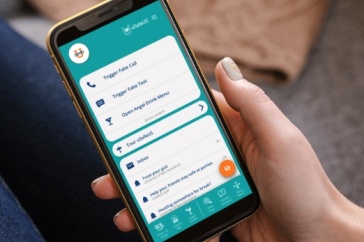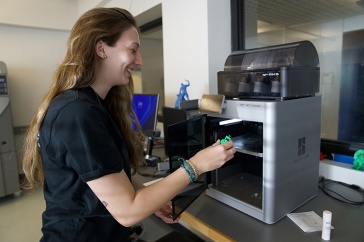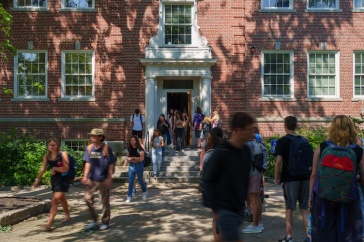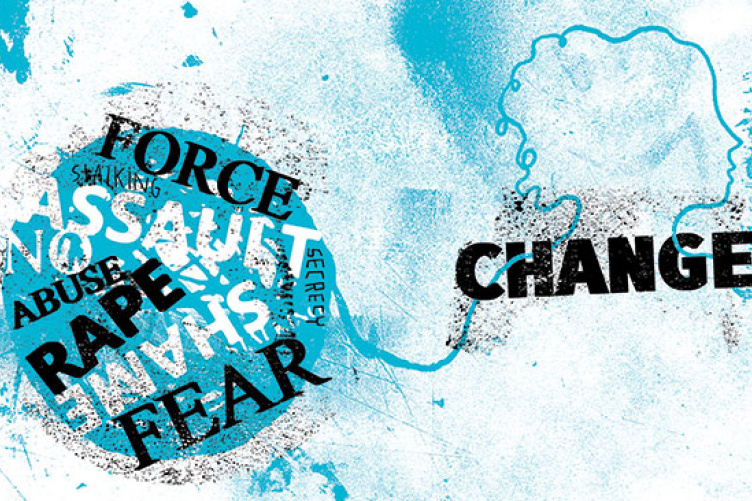
Chris Urbanski ’18 had gotten the message about sexual assault awareness at UNH long before he arrived on campus. At first-year orientation in June, older students told the newbies they should use the buddy system and watch out for each other at parties. In midsummer, Urbanski completed an interactive computer lesson—required for all 3,400 new students this year—explaining UNH policies and New Hampshire laws about sexual assault, relationship violence and stalking. His parents also had a conversation with him after they received an e-mail from UNH.
Still, the message seemed a bit academic until Urbanski arrived for the Pre-Orientation Volunteer Experience in Service program, where he took part in a 90-minute interactive workshop called Bringing in the Bystander®, which starts from the premise that everyone can help prevent sexual assault, relationship violence and stalking, and offers simple and effective ways for bystanders to intervene. The program hit Urbanski in the gut: He learned that one in four women and at least one in 16 men will be sexually assaulted during their college years, and he heard vivid examples of real rapes and assaults in which bystanders did nothing. That got him worrying about his girlfriend, who attends college in another state.
“This really spoke to you and brought a lot more emotion into it,” he says. “You really should intervene, because it’s dangerous if you don’t.”
Urbanski wasn’t the only one to get the memo. Before classes started, new students saw a performance by the student improv group WildACTs that portrayed an alcohol-fueled date rape, and watched a 10-minute video about sexual consent at their college assemblies. They will likely get the message again if they pledge a fraternity, play on a sports team, read the bulletin boards in their residence hall or take a class in psychology, sociology, criminal justice or women’s studies.
“To give them a 15-minute message at orientation is not enough,” says Sharyn Potter, an associate professor of sociology and co-director of Prevention Innovations, the UNH research and practice collaborative that created Bringing in the Bystander and Know Your Power®, a social marketing campaign featuring images with similar messages about positive bystander intervention. “The prevention message needs to be repeated in different ways and formats before it resonates with students and creates a campus culture of sexual respect.”
At first blush, the emphasis might seem excessive or alarming—a sign that UNH confronts a bigger sexual violence problem than other colleges. In fact, it’s just the opposite: UNH is winning recognition everywhere from The New York Times to Cosmopolitan to the U.S. Senate as a national leader in combating sexual assault, both for Prevention Innovations’ ground-breaking research and the university’s ambitious on-campus education and discipline efforts.
A National Crisis
Curbing campus sexual assault is very much on the minds of colleges across the country these days. In April, the U.S. Department of Justice released a list of 55 schools it was investigating for their handling of sexual assault cases under Title IX, a federal law that forbids sex discrimination at educational institutions. More schools have come under scrutiny since then, and a number of highly public protests—from that of a Columbia University student who has vowed to carry her mattress everywhere until her rapist is expelled to those of victims who have filed federal complaints against their schools with help from the activist group Know Your IX—have further thrust the issue into the national spotlight.
The investigations, in particular, were a wake-up call for colleges that had grown complacent about sexual assault—or even tried to sweep it under the rug—and now many are turning to Prevention Innovations for help. Earlier this year, the White House Task Force to Protect Students from Sexual Assault recommended Bringing in the Bystander and Know Your Power as well-researched programs for addressing sexual assault and dating violence. The task force also asked Prevention Innovations to become one of just four college groups to partner with it on new research: a multi-campus study of the most effective ways to educate students. Prevention Innovations recently won a $1 million federal grant to adapt Bringing in the Bystander for high school students, as well as a $600,000 grant to develop a video game for teaching bystander intervention. In the meantime, it has had so many requests for Bringing in the Bystander that instead of going to one campus at a time, it is inviting college officials to regional training sessions.
“It’s a really approachable program that students can relate to,” says Ally Manousos, prevention coordinator at the Sexual Assault Crisis Team in Barre, Vt., which offers programs at Norwich University. A recent graduate herself, Manousos is eager to introduce Bringing in the Bystander to Norwich’s corps of cadets, athletes and RAs. “It engages you and makes you want to do something the next time you see that situation.”
Hard Learned Lessons
UNH’s leadership status is no accident. The university got its own wake-up call 27 years ago: an ugly sexual encounter in February 1987 between three upperclassmen and a first-year student in Stoke Hall that set off a firestorm.
After getting drunk at a fraternity party, the first-year student had headed back to Stoke Hall by herself, but was intercepted by the three men, who brought her up to their floor. According to media reports at the time, at least two of the men had sex with her, and as one man bragged to others on the hall that they had “a train” going, word spread across the dorm. Alerted by two female students, an RA told the men to get the young woman out of their room because their actions could be perceived as rape, but left the woman to find her way back to her room by herself. She left, but a short time later the three men reappeared at her door, anxious for her to agree she had been a willing sexual partner. Then one of them had sex with her again.
Though she had no clear recall of the night’s events, the student went to Health Services for help. Her subsequent decision to file a police report and press for disciplinary action polarized the campus. Someone hung two male students in effigy from the front of Hamilton Smith Hall. Other people said the young woman had “asked for it” by getting drunk, or speculated that she had agreed to sex at the time, then cried “Rape!” to salvage her reputation. In March, the university held a public disciplinary hearing, with national media in attendance. The student’s advocate said it was gang rape: The young woman was too drunk to resist or consent to sex. But the three men, represented by lawyers, argued that she was an active and willing partner.
Prevention Innovations co-director Jane Stapleton ’90G was a graduate student in sociology at the time. She says it seemed as if the young woman was on trial. “It was so revolting. It was very re-victimizing,” she says. “The fact that she was under the influence of alcohol, the fact that she didn’t get up and walk out of the room—it was presented as her fault.”
In May, when the hearing board cleared all three men of sexual assault, hundreds of students, faculty, staff and community members protested, demanding that the men be expelled. Dozens of protesters occupied the dean of students’ office, where 11 were arrested—but they had made their point. Shaken administrators headed off to the summer break ready to examine UNH’s handling of sexual assaults.
First steps included hiring a full-time rape services coordinator—the genesis of SHARPP, UNH’s Sexual Harassment And Rape Prevention Program. It was the second rape crisis center to open on a college campus and remains one of just five nationwide. Then-president Gordon Haaland appointed a task force to consider changes, and funded an anonymous survey on students’ experiences of sexual assault. The results were startling. A whopping 37 percent of women students reported unwanted sexual contact during the first six months of the 1987-88 school year, including 10 percent who had been raped. For men, the figures were 11 percent and 4 percent. Other changes followed, but not in time for the Stoke Hall victim. Although county prosecutors charged two of the men with felony sexual assault, they pleaded guilty to misdemeanors and served only two months in jail. They returned to UNH after a six-month suspension, and their criminal records were annulled. The victim transferred to another college.
Lesson One: Teach Students to be Better Bystanders
The Stoke Hall episode and its aftermath had a profound effect on Stapleton, who changed her master’s thesis topic to examine acquaintance rape. After graduation, she worked for SHARPP for five years, and then went on to coordinate the university President’s Commission on the Status of Women and two other commissions, teach women’s studies classes and work with colleges and groups around the state to reduce sexual assault and domestic violence.
Stapleton was an independent consultant in 2003 when campus police chief Paul Dean asked her to administer a Justice Department grant to reduce sexual assaults at UNH. She used part of it to offer Bringing in the Bystander workshops to student groups and campus police. Psychology professor Victoria Banyard, women’s studies associate professor Mary Moynihan and then-SHARPP director Elizabeth Plante had developed the workshop under a National Institute of Justice grant. They used the Stoke Hall case as a teaching tool, asking participants, “Where were the bystanders?” who could have helped before, during and after the assaults. They also drew on a growing body of research showing that witnesses are more likely to intervene if they recognize a dangerous situation, someone asks them to help, they see someone else step in and they know how to be effective. Their research at UNH and elsewhere showed Bringing in the Bystander worked well with a broad range of groups.
“We trained some athletes, we trained Greeks, we trained orientation leaders, we trained police officers,” Stapleton says. “It’s probably the best-researched bystander intervention program in the country.”
Stapleton got a second grant and enlisted Potter to help her develop and research a social marketing campaign using visual images, Know Your Power, as a cost-effective alternative to Bringing in the Bystander. They assembled a committee of students, faculty and staff who met every two weeks to brainstorm realistic scenarios of bystanders intervening in dating violence and sexual assault. Then they piloted Know Your Power at UNH, flooding selected residence halls with the images. Surveys given to the students before and after indicated that those who were exposed to the images were more likely to recognize potentially dangerous situations and more willing to intervene.
“What we’ve established is both prevention strategies—Bringing in the Bystander and Know Your Power—change attitudes, increase bystander interventions and decrease rape myths,” Potter says.
Stapleton notes that bystander programs also foster a sense of community responsibility. Instead of treating all women like potential victims and all men like potential perpetrators, bystander programs are based on a positive idea: that everyone can help to end sexual assault, relationship violence and stalking. On a practical level, they also show students there are many ways to help, from pulling a potential perpetrator into a conga line at a party to accompanying a victim to the hospital.
Prevention Innovations, which was formally established in 2006, continues to update, adapt and research its programs in different settings, including at two U.S. Army posts in Europe. They have also created Know Your Power images to address male victims, as well as relationship and sexual violence in the LGBTQ community.
At the request of the White House task force, Potter is leading research at seven colleges this fall about the most effective ways—from e-mail, to online lessons, to in-person trainings—to make sure students understand campus sexual assault policies and state laws. The schools include a historically black college, a college serving a large Hispanic population, an Ivy League school, a small liberal arts college and two large public universities.
Closer to home, Prevention Innovations is working with SHARPP to evaluate the effectiveness of the messages bombarding UNH students, from the WildACTs show, to the online program, to SHARPP’s popular workshop on sexual consent: “Putting the yes, yes, YES back in sex.”
Lesson Two: Teach Consent
Year in and year out, SHARPP is on the front lines of UNH’s efforts to educate students. As 3,000-plus fresh faces arrive in Durham each fall, SHARPP’s first job is to teach them the importance of getting explicit consent from a sexual partner before each and every act—and that it’s not okay to have sex with someone who is drunk or drugged. That’s not clear to a lot of incoming students, who may think it’s normal in college to get drunk and hook up, says Maggie Wells, SHARPP’s education and outreach coordinator. “We’re trying to undo 18 years of culture when they get here,” she says.
Studies show that first-year students are more likely than upperclassmen to be sexually assaulted, especially during their first six to eight weeks on campus, when they may be drinking for the first time or drinking more than in high school, have no parental supervision and haven’t yet established a strong circle of friends to look out for them. SHARPP emphasizes the link between alcohol and sexual assault for good reason: Alcohol is the No. 1 date-rape drug on college campuses. Other studies show that only a small minority of college men—about 4 percent—are sexual predators, but they often mask their behavior as “normal” among all-male groups such as fraternities and athletic teams, which studies have linked to higher rates of drinking and sexual assault. At UNH, however, those groups have made great strides in recent years.
“We know that group-think is a real problem,” Wells says. But it can be harnessed for positive ends, too. “We’re a very sports-oriented culture. If you can get your athletes to act as role models, that can effect huge change. The same with fraternities.”
To that end, SHARPP has built relationships with fraternities, the Athletics Department, and other campus groups. UNH-recognized fraternities must do some educational programming each year. Choosing a SHARPP program is voluntary, but most fraternities do, and their favorite is “Putting the yes, yes, YES back in sex.” (Fewer sororities request SHARPP programming because their nationals often provide extensive education in dating and sexual violence.) In another sign of how much has changed since 1987, the fraternity where the Stoke Hall victim got drunk, Pi Kappa Alpha (Pike), has become one of Wells’ most devoted fans, inviting her back every year after new pledges join. That’s because her message is positive.
“We’re not talking about doom and gloom sexual assault,” Wells says. “When we’re talking about consent, what we’re really talking about is healthy sexuality.”
Pike’s president, Andrew Flaherty ’16, says his fraternity now has sober monitors at every party. Their sole job is to be hyper-vigilant that no one gets too drunk or too “handsy.”
“Because it’s going to happen: At every party scenario, there will be something along those lines,” Flaherty says. “We have no tolerance for any sexual abuse, whether man on woman or woman on man.” Pike is working toward becoming an official “Safe Zone” for gays, lesbians, and other sexual minorities. And the brothers have gotten the bystander message, too. “If you’re just sitting there, then you’re just as bad as the person who’s actually doing it,” he says.
SHARPP programming for first-year athletes also focuses on consent and reminds players to look out for their teammates, who could lose their scholarships and get kicked off the team or out of school if they commit sexual assault. During preseason of their second year, all athletes also go through the Mentors in Violence Prevention program, created by Northeastern University’s Center for Sport in Society. Like Bringing in the Bystander, MVP encourages athletes to set a good example or step in before things escalate.
Volleyball player Madison Lightfoot ’16 and her coach, Stacy Barnett, trained last winter as MVP facilitators. Lightfoot remembers feeling uneasy as a first-year student when she heard groups of guys catcalling or directing obscene comments toward women, because she’d never experienced that in high school. “What do you say in that situation if you don’t know either person? That was scary,” she says. Now if she hears a guy cat-calling, Lightfoot marches right up to him and asks, “Is that what you think you need to say to get a girl to notice you? What makes you think it’s OK to speak to anyone like that?”
Not everyone is comfortable being so confrontational, but athletes are a recognizable group who can model better behavior, Barnett says. “Recognition is huge. Strength in numbers is powerful,” she says. “If 600 student athletes have the same message, I think it resonates.”
Lesson Three: Confidential Counseling and Hearings
UNH is doing something right. Follow-up sexual climate surveys in 2000, 2006 and 2012 found a dramatic decline in the rate at which female students experienced unwanted sexual contact, from 37 percent in 1988 to 16 percent in 2012. The rate for men fell from 11 to 6 percent.
At the same time, the reporting of sexual offenses has increased—an indication that victims have more confidence in the campus judicial system, says Mark Rubinstein, vice president for student and academic services. For 2012, the latest year for which statistics are available, 20 sexual assaults were reported to campus authorities, whether an RA, the Office of Community Standards, or campus police. That’s the figure UNH must disclose under the Clery Act, which mandates that all colleges publish their crime statistics. While other colleges have lower numbers, that’s not always a sign they have fewer sexual assaults and rapes: Many campuses under investigation by the Justice Department were accused of discouraging victims from making an official report, putting an impossible burden of proof on victims or failing to remove rapists from campus.
“We’d like to have reports going down only because sexual assaults are going down—not because (victims) don’t feel like it’s worthwhile reporting,” Rubinstein says.
Stephen Nelson, director of the Office of Community Standards, says UNH has been doing a solid job addressing reported rapes for many years, but there’s always room for improvement. “We want to go above and beyond what’s required,” he says.
Right now, Nelson’s office is working on two changes recommended by the White House task force. The conduct code gives a range of possible punishments for various violations, but Nelson’s staff is compiling a more detailed guide showing what punishments UNH actually has handed down for specific infractions. And this year, for the first time, campus police will oversee the investigation of all sexual assault, stalking and relationship violence complaints, collecting evidence, interviewing witnesses and preparing reports for Nelson’s office. That change was prompted in part by the experience of other colleges facing lawsuits by male students who say their rights were violated during disciplinary proceedings, Nelson says.
Still, there are many victims who never tell anyone except a friend. Amber Carlson ’13, ’14G, who is writing her master’s thesis in Justice Studies on the Stoke Hall case, understands why. She was sexually assaulted her senior year while out drinking with friends at a bar; a man she was dancing with maneuvered her into a dark corner and shoved his hands up her pants. After a brief struggle, she broke free. She told a friend, a student advocate for SHARPP. But she didn’t go to police or campus authorities because she had been drunk and she didn’t know her assailant—or whether he was even a student.
“It’s a secret crime. It’s usually just the perpetrator and the victim, and you don’t have witnesses to say, ‘I saw this happen,’” she says. “And with alcohol, there’s an issue with memory.”
Yet Carlson can see how much the campus has changed since those fraught early months of 1987. Research she designed as an undergraduate showed that most students were clear on the definition of a sexual assault, whether the victim was male or female and whether the assailant was the opposite or the same sex. Most of them also knew it wasn’t okay to have sex with someone who was drunk.
Sexual assaults still happen, but they are less frequent, and students are more likely to step in, she says. She thinks the Stoke Hall victim would have a very different experience today.
“I don’t think she’d be left alone at a fraternity party. Now we stay very close to our friends,” Carlson said. “The RA would have done something: Their training is much better now that they are in collaboration with SHARPP. SHARPP would be involved, and there would be a choice” about reporting.
Stapleton, too, thinks often of the Stoke Hall survivor, who would now be in her mid-40s. This past June, speaking before the Senate Committee on Health, Education, Labor and Pensions, she testified, “I often wonder where and how (she) is, if she ever finished college, how she makes meaning of what was perpetrated against her. I would like her to know that things have changed, even though more change is needed, and that I and many other women and men have dedicated our lives to stopping very preventable crimes.”
Proven Prevention
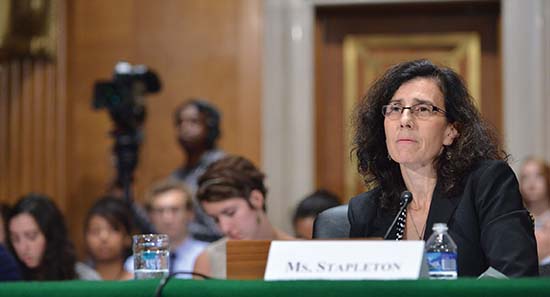
The reach of Prevention Innovations, Research and Practice for Ending Violence Against Women extends well beyond UNH. Two licensed and registered education programs developed by Prevention Innovations researchers, the Bringing in the Bystander® In-Person Prevention Program and the Know Your Power® Social Marketing Campaign, have been used by colleges and university campuses in the United States and Canada, adapted for the U.S. Army and, most recently, translated into Swedish. Both Bringing in the Bystander and Know Your Power are commercially available, with comprehensive and customizable materials that allow schools and other organizations to implement these proven programs in their community. Today, some 300 colleges, universities and other organizations in the United States and Europe are working with one or both of these two tools.
As the issue of sexual violence has gained increased scrutiny and national attention over the past three years, the group’s research and programs have been cited in everything from Cosmopolitan to National Public Radio to The New York Times and in European media outlets including The Guardian and BBC. The expertise of Prevention Innovations researchers is regularly sought at the highest levels of the U.S. government. In April, UNH was one of four universities tapped by a White House task force to conduct further research on ways to end campus sexual assault, with Prevention Innovations’ co-director Sharyn Potter as the principal investigator. In June, Potter’s co-director Jane Stapleton testified before the U.S. Senate Committee on Health, Education, Labor & Pensions as part of a full committee hearing on the reauthorization of the Higher Education Opportunity Act. Prevention Innovations researchers have also testified before the Department of Defense and researcher Victoria Banyard, an associate professor of psychology at UNH, is currently collaborating with the Department of Justice Office of Violence Against Women.
To find out how you can bring Prevention Innovations team members to your community, contact prevention.innovations@unh.edu.
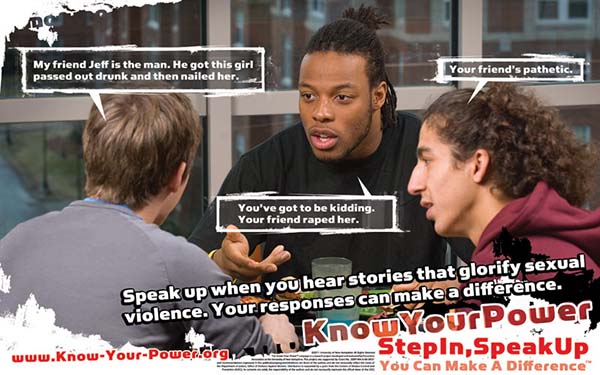
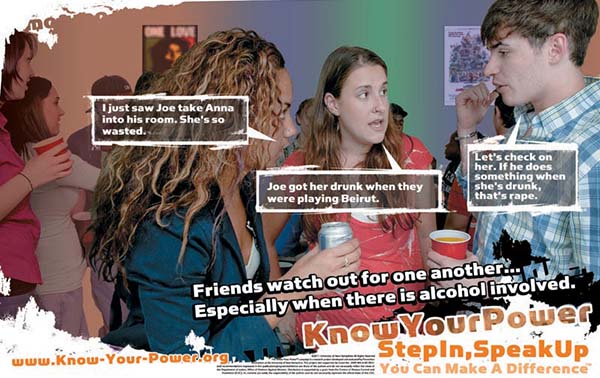
Originally published by:
UNH Magazine, Fall 2014 Issue
-
Written By:
Katharine Webster | freelance writer

















































